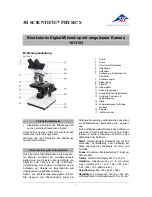
11
12
PROJECT #2: Animal Fur
You will need:
microscope
2 or more clean, blank slides
samples of different types of fur and hair
An animal’s fur is similar to the hair on your head. Like your hair, it protects
the skin underneath from cold, heat, and sunburn. Animals have different
kinds of fur. Some animals have fine, smooth fur. Others have stiff, bristly fur.
Some fur is short, and some fur is long. Long-haired animals can stay warm
even when it is very cold. Their fur traps and holds a layer of warm air next to
their skin. This is called
insulation
.
Study samples of fur from cats, dogs, and even your pet hamster. Check
paintbrushes you may have around the house. Some small paintbrushes have
hairs from squirrels. Other brushes may have bristles from pigs.
Put several strands of animal hair or fur in between a slide sandwich like you
did with the cloth fibers and look at them under your microscope. If you look
closely at 600X magnification, you might see small rough lines going around
each hair. These are growth lines. If there is a large space between these
lines, the hair is fast-growing. A lot of small spaces between lines indicate a
slow-growing hair.
Pull out a single hair from your head. (Ouch!) Does it look like any of the
animal hairs?
Notes:
Sample
#
Where is it
from?
Is the hair
smooth?
Would it keep
the animal
warm?
Can you see
growth rings?
#1
#2
#3
#4
#5
#6
PROJECT #3: Leaves
You will need:
microscope
2 or more clean, blank slides
different types of leaves
Plants breathe through their leaves! Most leaves have small holes in their
underneath side called
stomata
. Plants breathe in carbon dioxide from the
air and release oxygen back out. People do the opposite. We breathe in
oxygen and breathe out carbon dioxide. In this way people and animals help
plants and they help us. The scientific name for a relationship like this is a
symbiotic relationship
.
Collect leaves from different tree and plant types. The needles of pine, fir, and
spruce trees are also leaves, but they look a little different.
If you gather your leaves in the spring and summer, they will be mainly green.
In the fall and winter they may be red or brown or orange—all except the
small fir, pine, and spruce needles. They stay green all year round. The trees
from which these leaves come are called
evergreens
.
Look closely at your leaf samples at 300X magnification. Look for patterns of
lines running through the leaf. These are the veins of the leaf, and they carry
nutrients, or energy food, back and forth between the leaf and the main plant.
A plant’s leaves are like tiny food factories. Chlorophyll, a green chemical in
leaves, traps energy from sunlight. The plant uses this energy, water, and
carbon dioxide to make food in a process called
photosynthesis
.
Notes:
Sample
#
What plant is
it from?
What color
is it?
Can you see
the veins?
Can you see
the stomata?
#1
#2
#3
#4
#5
#6
Summary of Contents for MicroPro EI-5301
Page 1: ...EI 5301 Grades 3 Ages 8...





























